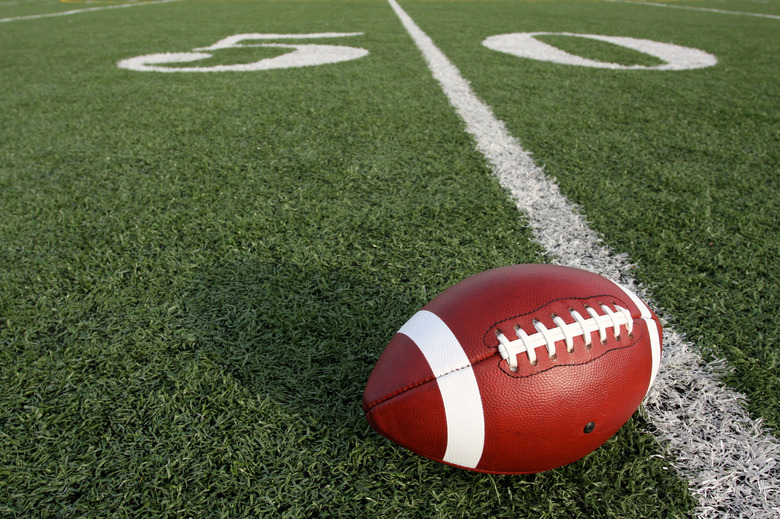Real Life Applications For Gas Laws
Over the centuries, scientists have discovered laws that explain how properties such as volume and pressure affect the way gases behave. You witness real life applications of at least one of these laws – Boyle's law – daily, perhaps without ever knowing you're observing important scientific principles in action.
Molecular Motion, Volume and Footballs
Molecular Motion, Volume and Footballs
According to Charles's law, volume increase is proportional to temperature increase if you heat a fixed amount of gas at constant pressure. Demonstrate this law by observing how an inflated football that has been indoors gets smaller if you take it outside on a cold day. Propane distributors take advantage of Charles's law by lowering temperature to -42.2 degrees Celsius (-44 Fahrenheit) – an action that converts propane to a liquid that's easier to transport and store. Propane liquefies because as temperature drops, the gas's molecules get closer together and volume decreases.
Breathing Made Difficult Courtesy of Dalton's Law
Breathing Made Difficult Courtesy of Dalton's Law
Dalton's law says that a gas mixture's total pressure equals the sum of all gases contained in the mixture, as shown in the following equation:
\(\text{total pressure}=\text{pressure}_1+\text{pressure}_2\)
This example assumes that only two gases exist in the mixture. One consequence of this law is that oxygen accounts for 21 percent of the atmosphere's total pressure because it makes up 21 percent of the atmosphere. People who ascend to high altitudes experience Dalton's law when they try to breathe. As they climb higher, oxygen's partial pressure decreases as total atmospheric pressure decreases in accordance with Dalton's law. Oxygen has a difficult time making it into the bloodstream when the gas's partial pressure decreases. Hypoxia, a serious medical problem potentially resulting in death, can occur when this happens.
Surprising Implications of Avogadro's Law
Surprising Implications of Avogadro's Law
Amadeo Avogadro made interesting proposals in 1811 that now formulate Avogadro's law. It states that one gas contains the same number of molecules as another gas of equal volume at the same temperature and pressure. This means that when you double or triple a gas's molecules, the volume doubles or triples if pressure and temperature remain constant. Masses of the gasses will not be the same since they have different molecular weights. This law holds that an air balloon and an identical balloon containing helium don't weigh the same because air molecules – consisting primarily of nitrogen and oxygen – have more mass than helium molecules.
The Magic of Inverse Pressure Relationships
The Magic of Inverse Pressure Relationships
Robert Boyle also studied the intriguing relationships between volume, pressure and other gas properties. According to his law, a gas's pressure times its volume is a constant if the gas functions like an ideal gas. This means that a gas's pressure times volume at one moment equals its pressure times volume at another after you adjust one of those properties. The following equation illustrates this relationship:
\(P_1V_1=P_2V_2\)
In ideal gases, kinetic energy comprises all the gas's internal energy and a temperature change occurs if this energy changes. (ref 6, first paragraph re this definition). This law's principles touch several areas in real life. For instance, when you inhale, your diaphragm increases the volume of your lungs. Boyle's law holds that lung pressure decreases, causing atmospheric pressure to fill the lungs with air. The reverse happens when you exhale. A syringe fills using the same principle pull its plunger and the syringe's volume increases, causing a corresponding pressure decrease inside. Because the liquid is at atmospheric pressure, it flows into the low-pressure area inside the syringe.
References
Cite This Article
MLA
Lee, Kevin. "Real Life Applications For Gas Laws" sciencing.com, https://www.sciencing.com/real-life-applications-gas-laws-5678833/. 7 December 2020.
APA
Lee, Kevin. (2020, December 7). Real Life Applications For Gas Laws. sciencing.com. Retrieved from https://www.sciencing.com/real-life-applications-gas-laws-5678833/
Chicago
Lee, Kevin. Real Life Applications For Gas Laws last modified March 24, 2022. https://www.sciencing.com/real-life-applications-gas-laws-5678833/
